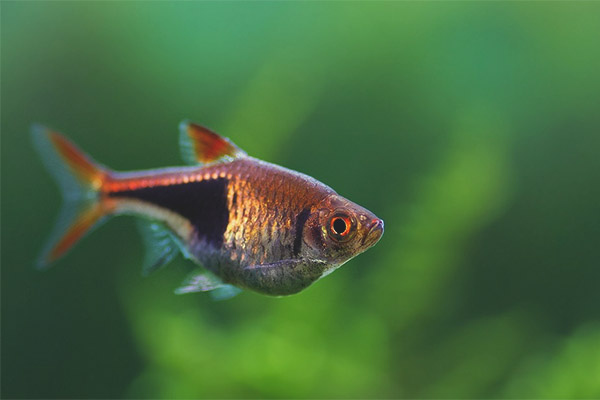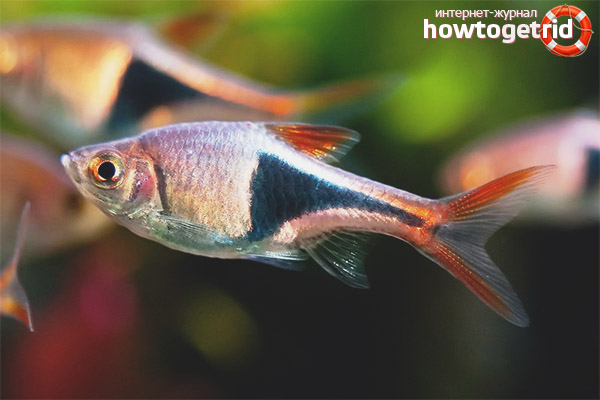The content of the article
Rasbor heteromorphs or rasbor klinopyatnistye (wedge-shaped) - popular and common aquarium fish, which are sold in almost all pet stores. They are small in size and perfectly cohabit with their relatives.
In natural conditions
The most famous type of rasbor are considered klinopyatnistye rasbor that live in Asian countries: Sumatra, Borneo, Singapore, Thailand and Malaysia.
Their habitats are small rivers and streams that are located near the jungle. The waters in them are sour and soft, rich tea-colored, in which they are painted leaves, which fell on the water. In nature, they live in packs. Their diet consists of various insects.
Appearance
Family rasbor has about 50 different species.The most popular for aquarium content are heteromorphs or wedge-shaped species. They have miniature size and bright showy color. The body length of these fish does not exceed 4 cm. They have a copper-colored body, on the body there is a large black speck of a wedge-shaped form. It was the color that caused the name of this species. These fish live from 3 to 4 years.
Gender Differences
In addition, the males are slimmer and have an olive-green color of the back, and the belly is silver. The fins in the abdomen are pale pink, while the caudal and dorsal fins are red.
Content Features
For the content they are completely unpretentious. It is this factor, together with their small size and attractive appearance, that became the main cause of their prevalence. Despite the fact that under natural conditions, they prefer acidic water, in the aquarium rasobori cynopyatnistye can adapt to its other parameters.
Nutrition
By analyzing the content of the digestive tract rasbora that live in natural conditions, it was found that their diet consists of various insects: worms, larvae, zooplankton.
In artificial ponds, the cunetous rasbora feeds on any available food. Nevertheless, it is preferable to feed these small fish with live or frozen feed: Artemia, bloodworms, and pipe builder. This diet helps to increase their activity and more saturated and attractive color. It is necessary to take into account that rasbor have mouths of rather small sizes. For this reason, it is preferable to feed in small portions.
In aquarium conditions
Aquarium fish rasborov completely unpretentious and able to adapt to any conditions. They live in a small sized aquarium. For flocks, a reservoir of about 40 liters is enough.
Preferably, the water had an acidity in the range from 6 to 7, 8 PH and hardness up to 15 dH. Nevertheless, they can feel great in its other parameters. But for reproduction rasbor they must be within these limits.
Clean water is very important for fish of this species. Therefore, predominantly filtering should be present. It is not necessary to use powerful filters, as long as it is in principle. Every week it is necessary to replace a quarter of the water with a new one.
In the aquarium, where rasbora will be kept, there must be a lot of plants, but there is enough space for the fish to move freely. It is advisable to use algae that grow in their natural environment. Preference should be given aponogetonu and cryptocoryne, but you can use other types.
Be sure to arrange shelters for these little fish, so they feel comfortable. It is desirable that on the surface of the aquarium were floating algae. This will help create more natural conditions as close as possible to natural ones.
It is imperative to keep them in flocks for the reason that in natural conditions they exist in this way. The flock should include from 7 individuals.
The lighting in the tank should be diffused and muffled. Preferably the use of dark soil.
Neighborhood
Peace-loving and picky rasborov perfectly suited for those who have no experience of keeping fish in aquarium conditions. There is no need to create special conditions for them, and they are able to get along with small and calm fish of their own. The best neighbors for rasbor are neon, black neon, erythrosalonus and priestla.
It is categorically contraindicated to hook up to representatives of large-sized predators, such as cichlids, piranhas, and scalarines. They are happy to enjoy these charming fish.
Breeding

Klinopyatnistye rasbor not very willing to breed at home. Spawning occurs only when there are ideal water parameters in the tank. Future parents need to provide quality food. Suitable age for breeding is from 9 months to a year.
For spawning, it is preferable to move them to another tank with a volume of 15 liters, the water level of which should be from 15 to 20 cm. It is necessary that there should be at least 2 males per female. Water parameters for dilution should be softer, but not lower than 2 dGH.The ideal temperature is about 27 degrees. In the reservoir for spawning, the presence of cryptocrine shrubs or other large algae, which have broad leaves, is mandatory.
Important! For successful spawning the aquarium should be pre-sanitized.
After preparing the aquarium, a female with two males is placed in it. The most suitable time for this is evening. In the morning the fish begin to spawn. Males start flirting with females and hiding with them in algae.
During readiness, the females turn belly up, hiding under a wide leaf of the plant with the male. During this, the females lay their eggs, hiding them under the leaf, which the males then inseminate. Spawning continues for several hours. During this time, the rasbor lay several hundred eggs.
At the end of the spawning season, adult fish are resettled in a familiar reservoir. This should be done so that the adult persons do not eat the fry, which should soon hatch. Fry of eggs appear within 24 hours and after a week they begin to swim. They feed small fish with small foods with a high content of protein - ciliates and egg yolks.The babies are quite fast growing and reach 1 cm by the first month. Before they are resettled to another tank, help the fry to adapt to harder water, gradually increasing the level of hardness in the aquarium where they are kept.
Rasbor are great for home maintenance, especially for inexperienced aquarists. They are peaceful and calm, do not require special skills and are not capricious.
Video: aquarium fish rassom heteromorph












To send